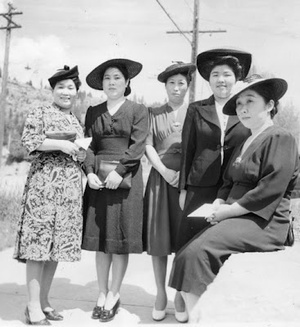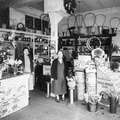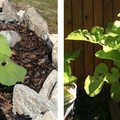I don’t have a PhD in linguistics but I hope that a budding linguist major will get interested in this topic. In Hawaii, the first boat load of about 150 Japanese immigrants came to this island as sugar cane laborers in 1868. It was called Gannen-mono, first-year people. However, it proved to be an unsuccessful venture. They were city dwellers, not really farm workers. Nearly one third of gannen-mono immediately returned to Japan because of their work conditions. In 1882, the Chinese Exclusion Act came into effect once the US took hold of Hawaii. Therefore, a considerable work force was needed for the sugar cane industry.
In 1885, King David Kalakaua and Robert Irwin personally visited Japan to recruit labourers for the fast-growing sugar cane industry. Many thousands came from Yamaguchi, Hiroshima, and Kumamoto prefectures. Robert Irwin, who was married to a Japanese woman, knew that when the immigrants arrived in Hawaii, the workers had to be segregated in prefectures. Thus, the Hiroshima group went to one plantation and the Yamaguchi labourers went to another. They took into account the differences in their customs, diet, and dialect so as to make it more homogenous. Seventy percent of the workers were Japanese. Remaining groups were Filipinos, Puerto Rican, and others. The luna or foreman in charge of the crew couldn’t speak three or four different languages to give orders, therefore, Pidgin English evolved in order that all ethnic groups could understand the instructions. One example of a humorous Pidgin that is Japanese-related was hanabata. It meant “nose mucous”!
Unlike Hawaii, the Japanese immigrants who arrived in Canada came from various prefectures. Steveston was homogenous because Gihei Kuno brought his friends and relatives from Mio-mura who spoke Kishu-ben in Wakayama Prefecture. However, on Powell Street or Japantown, there were labourers who came from all over southern and western Japan. There were Wakayama workers there too. However, people knew where they came from just by listening to their friends talk. For instance, a person from Hiroshima might say it this way, “Etto no, samui ga no!” (Isn’t it cold!). Kansai dialect might sound like this, “Shiran wa na. Akan wa na” (I don’t know, it’s no good). A Kagoshima lady might say, “Shi-to-ran” (I don’t know). When Powell Street boomed, I think many Shiga-ken merchants and businessmen came from the Lake Biwa area, close to Kyoto. I’m not too familiar with this dialect, but Frank Maikawa said in his story that Shiga-ken dialect sounded feminine compared to Kishu dialect! Most of the Kishu people were fishermen and they talked gruffly, thus it sounded more masculine.
Thanks to the Japanese Language School being established in the early 1900s, this may have standardized the Japanese language. However, speaking to older Nisei who were children, they told me that they were more interested in playing so they didn’t put in much effort. Once children returned home after school, they most likely reverted to the parents’ dialect. When younger Nisei started attending regular public school such as Strathcona, English probably became more comfortable to use among friends.
In Steveston, students weren’t allowed to attend Lord Byng Elementary because parents didn’t pay local taxes, since most families lived in cannery row houses. It wasn’t until 1923 that the Nisei students were able to attend public school. Harry Imai told me that they spoke English in class but once they were out for recess and lunch, they spoke “Japanese.”
From 1942–1945, most Japanese Canadians were forced to relocate to various internment camps. This made it more complicated, since Steveston and Powell Street families were placed together. Steveston’s Kishu-ben (Wakayama) was not the people’s choice of Japanese. They were looked down as being a rough and crude dialect. Powell Street usage of Japanese was more refined to some extent. However, one thing I noticed when I was living in Greenwood, is that when former Steveston parents met someone on the street who spoke a different dialect, they would automatically speak the polite, formal Japanese.

Greenwood had families predominantly from Steveston so it was much more consistent. It was Steveston all over again. The ladies would be seen shopping in town, and they would greet each other with, “Haa-looo, doh-nai, genki-kai?” (Hello, how are you, you healthy?). The men’s greeting might go like this (guttural sound), “Oiii, doh-nai, gaina atsui-na!” (Hey, how are you, hot eh?).
My older brother Kaz told me that when dad opened the pool hall, there were young men from Powell Street who couldn’t speak Japanese, so they learned the Kishu-ben dialect spontaneously. The pool hall language was rowdy to begin with, especially when they missed their game ball. An Issei swearing might go like this, “Jeez Kurai-su, goat-ta hellu, sakana bechi, sakura-mento, Santa Maria!”
There was no Japanese Language School in Greenwood so children learned it on the fly. I’m sure different dialects were mixed together! It was totally confusing. Since birth we learned that mimi was ears and hana was nose. Therefore, some of us thought that meh-meh, teh-teh were proper Japanese. We found out in our adulthood that meh-meh for eyes, in correct form, was meh and teh for hands. All along we were speaking baby-talk: eye-eye and hand-hand!
Issei and older Nisei used to say Shina-jin rather that Chugoku-jin for Chinese and Chosen-jin (Kankoku-jin) for Korean. Issei got by with pidgin English but Nisei children were well-versed in English and Japanese.
Most of the Steveston parents in Greenwood basically spoke Japanese, therefore children needed to speak to them in their dialect. Therefore, going to public school was very difficult. The Franciscan Sisters who taught at Sacred Heart School (SHS), told their students that they MUST speak English in class but they turned a blind eye during recess and lunch. Little did we know some of the Sisters understood Japanese!
In 1954, students were transferred to the public school when SHS closed down. Again, it was very challenging to comprehend English when Japanese was still more comfortable to use. In my later life, I thought that we all had difficulty with the English language but that was not the case. In 1945–46, at Greenwood High School, the grade 12 graduation class was all Nisei. Obviously, attending Strathcona and Lord Byng Elementary helped them understand their school work. Those who were born in Greenwood had a much more difficult time in school. Quite a few students dropped out of school to work in the local sawmill. Our 1963 class had the most students attend university. Yet I still struggled with the English language.
Some Nisei children spoke mixed English–Japanese. For example, a conversation might have gone like this, “Geez. It’s atsui na. Let’s go swimming. Yoyogo yo.” The reply would be, “ya, iko.” On the flipside, their Japanese wasn’t accurate or precise. In the 1960s, when single ladies started to earn good money, they decided to go to Japan for the very first time. In the restaurant, one Nisei lady told her traveling companions, “Hey, hara ga hetta na. Let’s eat!” The Japanese customers in the restaurant were in total shock that the pretty young Nisei lady was speaking in a very masculine tone! It was an awkward moment for sure.
We used the word ramune for soda pop, but it’s kola in Japanese. When I “lived” in Japan for a year in 1979–80, I told the ladies who were studying English at my friend’s condo that I was going to put my pants on, I said, “Pantsu, haku kara ne.” The ladies laughed! One lady explained to me that pantsu was ladies’ panties. Never heard of zubon in Canada.
So, what to make of all of these confusing times the Nisei went through? Most Nisei knew the basic Japanese words, but they just needed to refine the sentence structure. After living in Canada for a very long time, English became Nisei’s first language, but they could still understand Japanese. With the Sansei and Yonsei, however, most couldn’t communicate with their Japanese-speaking grandparents or great-grandparents.
Now, whenever I hear Kishu-ben spoken in Steveston, it is “comfort food” for me. I find it so “down to earth.” Yet, others might perceive it to be “earthy.” I think it’s imperative that young Nikkei children learn more than one language. Pidgin English is now the official language of Hawaii. With so many different ethnic groups in the lower mainland, like in Hawaii, I wonder if a new language will evolve in the future?
How can you tell a Nisei? They might throw in a few Japanese words while speaking English. “That guy is sure bakatare, eh?
*This article was originally published in the Geppo The Bulletin: a journal of Japanese Canadian community, history + culture, May 2016 issue.
© 2016 Chuck Tasaka






